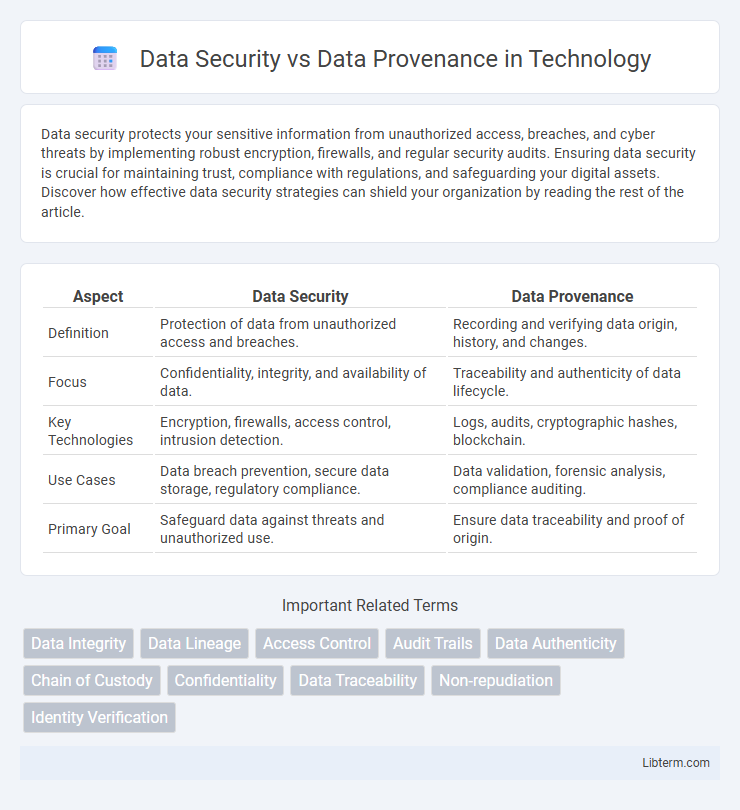Data security protects your sensitive information from unauthorized access, breaches, and cyber threats by implementing robust encryption, firewalls, and regular security audits. Ensuring data security is crucial for maintaining trust, compliance with regulations, and safeguarding your digital assets. Discover how effective data security strategies can shield your organization by reading the rest of the article.
Table of Comparison
| Aspect | Data Security | Data Provenance |
|---|---|---|
| Definition | Protection of data from unauthorized access and breaches. | Recording and verifying data origin, history, and changes. |
| Focus | Confidentiality, integrity, and availability of data. | Traceability and authenticity of data lifecycle. |
| Key Technologies | Encryption, firewalls, access control, intrusion detection. | Logs, audits, cryptographic hashes, blockchain. |
| Use Cases | Data breach prevention, secure data storage, regulatory compliance. | Data validation, forensic analysis, compliance auditing. |
| Primary Goal | Safeguard data against threats and unauthorized use. | Ensure data traceability and proof of origin. |
Introduction to Data Security and Data Provenance
Data security involves protecting digital information from unauthorized access, corruption, or theft through encryption, access controls, and secure protocols, ensuring confidentiality, integrity, and availability. Data provenance tracks the origin, movement, and transformations of data throughout its lifecycle, enabling transparency, traceability, and accountability in data management. Combining data security with data provenance enhances the reliability and trustworthiness of data by providing both protection and detailed audit trails.
Defining Data Security: Key Concepts
Data security encompasses the protection of digital information from unauthorized access, corruption, or theft through encryption, access controls, and authentication mechanisms. It aims to ensure confidentiality, integrity, and availability of data across systems and networks. Key concepts include risk management, data classification, and compliance with standards like GDPR and HIPAA to safeguard sensitive information effectively.
Understanding Data Provenance: Core Principles
Data provenance involves tracking the origin, history, and transformations of data to ensure its authenticity and integrity, which is crucial in data security frameworks. Core principles include establishing a detailed audit trail, ensuring transparency of data lineage, and maintaining verifiable records to prevent tampering or unauthorized modifications. Understanding these elements helps organizations enhance trust, comply with regulations, and support data governance initiatives effectively.
Importance of Data Security in Modern Organizations
Data security is critical in modern organizations to protect sensitive information from breaches, unauthorized access, and cyber threats that can lead to financial loss and reputational damage. Effective data security measures such as encryption, access controls, and regular audits help ensure compliance with regulations like GDPR and HIPAA. Maintaining robust data security safeguards organizational assets and builds trust with clients and stakeholders in an increasingly digital business environment.
Role of Data Provenance in Data Integrity
Data provenance plays a crucial role in data integrity by providing a detailed record of the origin, history, and transformations of data throughout its lifecycle. This traceability enables verification of data authenticity and detection of any unauthorized alterations, thereby enhancing the reliability and trustworthiness of datasets. While data security focuses on protecting data from unauthorized access, data provenance ensures the integrity and accountability of data by maintaining a transparent audit trail of its lineage.
Differences Between Data Security and Data Provenance
Data security focuses on protecting data from unauthorized access, breaches, and corruption through encryption, access controls, and secure authentication mechanisms. Data provenance, however, emphasizes tracking the origin, history, and transformations of data to ensure its authenticity, integrity, and traceability throughout its lifecycle. While data security safeguards data confidentiality and availability, data provenance provides transparent auditing trails and accountability for data usage and modifications.
How Data Provenance Enhances Data Security
Data provenance enhances data security by providing a detailed, verifiable record of data origin, transformations, and access history, which enables organizations to detect unauthorized changes and ensure data integrity. By maintaining an immutable audit trail, data provenance supports compliance with regulatory standards such as GDPR and HIPAA, reducing risks associated with data breaches and insider threats. Integrating provenance metadata with security protocols strengthens authentication processes and enables rapid forensic analysis during security incidents.
Common Challenges in Implementing Data Security and Provenance
Implementing data security and data provenance faces common challenges such as ensuring data integrity, managing access controls, and maintaining comprehensive audit trails in complex IT environments. Both require robust encryption techniques and real-time monitoring to detect unauthorized access or alterations, complicating scalability and performance. Integration difficulties with existing systems and compliance with regulatory standards further complicate the simultaneous enforcement of security policies and provenance tracking.
Best Practices for Integrating Data Security and Provenance
Effective integration of data security and data provenance requires implementing robust encryption methods alongside comprehensive audit trails to ensure both confidentiality and traceability. Utilizing blockchain technology can enhance data provenance by providing immutable records while maintaining secure access controls to protect sensitive information. Establishing strict identity management and real-time monitoring further strengthens the synergistic approach, enabling organizations to detect unauthorized activities and verify data origin simultaneously.
Future Trends in Data Security and Data Provenance
Future trends in data security emphasize the integration of advanced encryption techniques and AI-driven threat detection to protect sensitive information against evolving cyber threats. Data provenance is increasingly leveraging blockchain technology to ensure immutable and transparent audit trails, enhancing data integrity and trustworthiness across decentralized systems. The convergence of these fields fosters robust frameworks that guarantee both the confidentiality and verifiability of data in complex digital ecosystems.
Data Security Infographic

 libterm.com
libterm.com